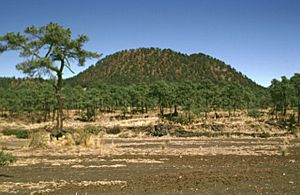Xitle facts for kids
Xitle (say "SHEET-leh") is a special type of volcano called a monogenetic volcano. This means it erupted only once. Its name comes from the Nahuatl language and means "navel," which is like a belly button.
Xitle is found in the Ajusco mountain range, inside the Cumbres del Ajusco National Park. It's located in the southwestern part of Mexico City, in an area called Tlalpan.
This volcano is an ash cone volcano. It looks like a cone with a round bottom. It stands about 300 meters (almost 1,000 feet) tall. Its sides are quite steep, sloping between 30 and 40 degrees.
Contents
When Did Xitle Erupt?
Xitle erupted a very long time ago. Scientists used a method called radiocarbon dating to figure this out. This method helps them find the age of old things. They believe Xitle erupted sometime between the years 245 AD and 315 AD.
However, some other sources suggest the eruption might have happened even earlier, in the 1st century BC.
What Happened After the Eruption?
The eruption of Xitle had a huge impact on the land and the people living nearby.
The Pedregal Lava Fields
One major result was the creation of the Pedregal de San Ángel lava fields. These are large areas covered in hardened lava rock, located south of Mexico City. Imagine hot, flowing rock cooling down and turning into a rocky landscape!
The City of Cuicuilco
The eruption also destroyed an important ancient city called Cuicuilco. This city was one of the most advanced places in Mesoamerica, a region in ancient Central America. The lava from Xitle covered and buried Cuicuilco.
People Moved and Cultures Changed
After their city was destroyed, the people of Cuicuilco had to leave their homes. This movement of people is sometimes called a diaspora. As they moved across central Mexico, they shared their culture and ideas. This spread of culture even affected another powerful ancient city nearby, called Teotihuacan, leading to important changes there.
See also
 In Spanish: Xitle para niños
In Spanish: Xitle para niños


